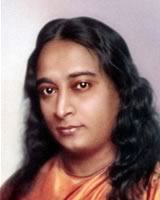Learn To Meditate
Eastern Techniques
Western Techniques
Paramahansa Yogananda
 Paramahansa Yogananda was born Mukunda Lal Ghosh on
January 5, 1893, in Gorakhpur, India, into a devout and well-to-do Bengali
family. From his earliest years, it was evident to those around him that
the depth of his awareness and experience of the spiritual was far beyond
the ordinary. In his youth he sought out many of India's sages and saints,
hoping to find an illumined teacher to guide him in his spiritual quest.
Paramahansa Yogananda was born Mukunda Lal Ghosh on
January 5, 1893, in Gorakhpur, India, into a devout and well-to-do Bengali
family. From his earliest years, it was evident to those around him that
the depth of his awareness and experience of the spiritual was far beyond
the ordinary. In his youth he sought out many of India's sages and saints,
hoping to find an illumined teacher to guide him in his spiritual quest.
It was in 1910, at the age of 17, that he met and became a disciple of the revered Swami Sri Yukteswar Giri. In the hermitage of this great master of Yoga he spent the better part of the next ten years, receiving Sri Yukteswar's strict but loving spiritual discipline. After he graduated from Calcutta University in 1915, he took formal vows as a monk of India's venerable monastic Swami Order, at which time he received the name Yogananda (signifying bliss, ananda, through divine union, yoga). His ardent desire to consecrate his life to the love and service of God thus found fulfillment.
Meditate using Kriya Yoga
In 1920, Yogananda was invited to serve as India's delegate to an international congress of religious leaders convening in Boston. His address to the congress, on "The Science of Religion," was enthusiastically received. That same year he founded Self-Realization Fellowship to disseminate worldwide his teachings on India's ancient science and philosophy of Kriya Yoga and its time-honored tradition of learning and teaching how to meditate.
Over the next decade, Yogananda traveled and lectured widely, speaking to capacity audiences in many of the largest auditoriums in the country -- from New York's Carnegie Hall to the Los Angeles Philharmonic. The Los Angeles Times reported: "The Philharmonic Auditorium presents the extraordinary spectacle of thousands....being turned away an hour before the advertised opening of a lecture with the 3000-seat hall filled to its utmost capacity."
Among those who became his students were many prominent figures in science, business, and the arts, including horticulturist Luther Burbank, operatic soprano Amelita Galli-Curci, George Eastman (inventor of the Kodak camera), poet Edwin Markham, and symphony conductor Leopold Stokowski. In 1927, he was officially received at the White House by President Calvin Coolidge, who had become interested in the newspaper reports of his activities.
During the 1930s, Paramahansa Yogananda began to withdraw somewhat from his nationwide public lecturing so as to devote himself to the writings that would carry his message to future generations, and to building an enduring foundation for the spiritual and humanitarian work of Self-Realization Fellowship (known in India as Yogoda Satsanga Society).
Yogananda's life story, Autobiography of a Yogi, was published in 1946 and expanded by him in subsequent editions. A perennial best seller, the book has been in continuous publication since it first appeared and has been translated into 18 languages. It is widely regarded as a modern spiritual classic.
On March 7, 1952, Paramahansa Yogananda entered mahasamadhi, a God-illumined master's conscious exit from the body at the time of physical death. His passing was marked by an extraordinary phenomenon. A notarized statement signed by the Director of Forest Lawn Memorial-Park testified: "No physical disintegration was visible in his body even twenty days after death....This state of perfect preservation of a body is, so far as we know from mortuary annals, an unparalleled one....Yogananda's body was apparently in a phenomenal state of immutability."
To learn to meditate will open your own creative mind and reduce negative thinking.
Let peaceful thoughts flow into your mind like streams flows into the ocean
Please email your thoughts, suggestions and inspirations to us by Clicking Here.
